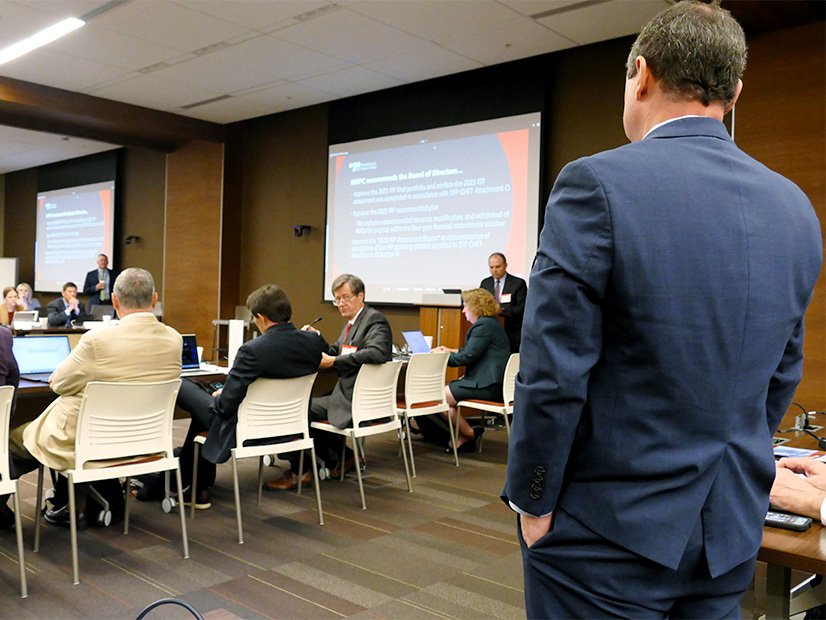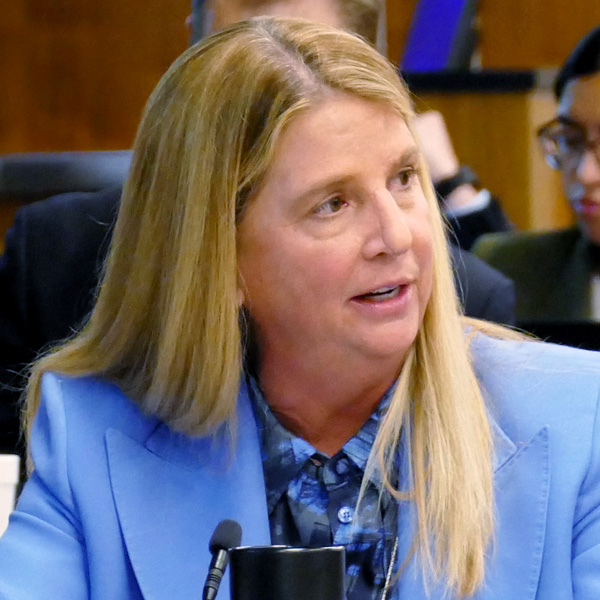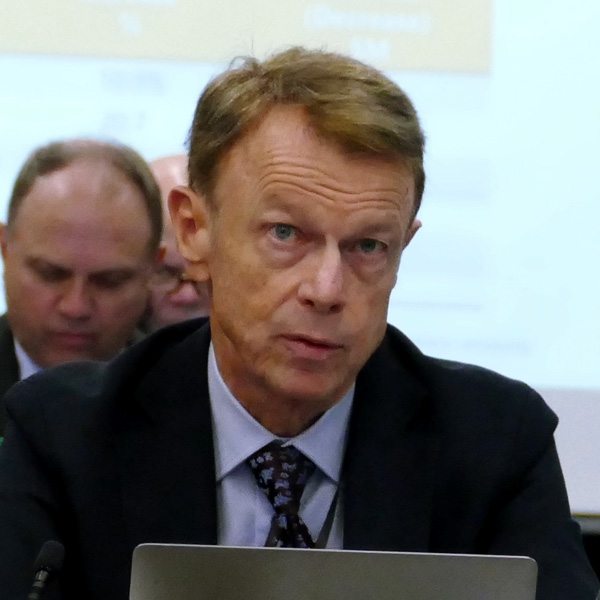LITTLE ROCK, Ark. — SPP has its strategic priorities, as do all grid operators, and resource adequacy is one of them.
It is also the RTO’s No. 1 strategic priority.
“It’s all over your agenda today,” SPP CEO Barbara Sugg said in opening the recent meeting of the Regional State Committee (RSC), which comprises the RTO’s state regulators. “It’s been a No. 1 priority for us, particularly since Winter Storms Uri and Elliott.”
The Resource and Energy Adequacy Leadership (REAL) Team, a cross-section group of regulators, directors and stakeholders, is the answer. After inside jokes during the team’s first few months (“Yes, we will really be meeting soon.”), the team has set an aggressive schedule in assessing SPP’s current resource adequacy construct and providing guidance and policy recommendations to ensure sufficient energy is available to meet load requirements.
The group, led by Texas Public Utility Commissioner Will McAdams, and its subgroups brought two key resource adequacy policies for approval during the October governance meetings. Next year, it plans to present a maintenance outage policy, value-of-lost-load and expected unserved energy metrics and associated usage policies, and a winter planning reserve margin.
And that’s just through April.
“I am particularly pleased with the REAL Team,” Sugg said. “What really excites me about this is it is a joint committee, if you will, with seats at the table for the RSC and the board and the stakeholders. I personally would love to see this continue as a longstanding committee in the future because I think there is tremendous value to be gained by us sitting around the table and working together.”
During what RSC President and Kansas Corporation Commissioner Andrew French called a “lively meeting with lots of opinions shared,” the regulators on Oct. 30 approved two revision requests brought forward by the REAL Team that lay out a performance-based accreditation (PBA) policy (RR554) for conventional resources and effective load-carrying capability (ELCC) accreditation (RR568) for wind, solar and storage resources. The Board of Directors approved the RRs the next day.
“It’s been a real innovative and valuable approach to problem solving,” Sugg said during the RSC meeting. “I’m sure there are other problems we can solve together, and I look forward to that. The team has a work plan, and we’ll be bringing more resource adequacy policies in the coming quarters as well. That collaboration is outstanding.”
“The key thing from the REAL Team is to improve the cycle time between the key working groups and the committees to ensure we move through these very critical decisions as quickly as possible,” SPP Director John Cupparo said. “I would encourage the key folks involved in the REAL Team and around the team to take the opportunity to kind of clarify the relationships between the working groups, because [that] will ultimately benefit all of us as these decisions continue to come forward.”
RR568 is a response to FERC’s rejection earlier this year of SPP’s first attempt to add ELCC (the amount of incremental load a resource can dependably and reliably serve during peak hours). The revision reduces a three-tiered structure to just two, firm and non-firm transmission service. Staff will study only firm service in its ELCC analysis. (See FERC Grants Rehearing of SPP Capacity Accreditation Proposal.)
RR554 was approved after restoring the use of seven years of historical data, rather than 10, in calculating conventional resources’ accredited capacity. The Markets and Operations Policy Committee had rejected the seven-year figure and endorsed 554 with 10 years of historical data.
SPP’s Market Monitoring Unit had initially proposed five years of historical data but settled on the seven-year compromise during a September meeting with the REAL Team. (See SPP REAL Team Compromises on PBA, ELCC Revisions.) Smaller utilities have sided with the 10-year figure, saying it would give them and their smaller fleets more time to meet resource requirements.
The board also approved a Supply Adequacy Working Group (SAWG) policy paper on demand response and its planned direction on fuel assurance, both of which previously were endorsed by the RSC and MOPC. They will be converted into RRs and brought back to the board for final approval.
The first policy will facilitate diverse DR programs by considering the potential for increases in large loads that may claim its accreditation. SAWG members say the grid operator must accurately accredit DR resources according to their reliability contribution and develop qualification standards to drive consistency.
The fuel assurance policy will incorporate PBA weighting based on critical system periods and considers modifications to the out-of-management-control exceptions related to fuel-related outages. The SAWG also will consider a policy for PBA and ELCC adjustments to reflect new reliability investments and recommends SPP improve operational dispatch strategies to start units before extreme cold weather and keep them online.
RSC, Board OK Sunflower Waiver
Sunflower Electric Power finally was given some potential relief for congestion from renewable resources in its pricing zone when regulators and the directors both approved RR584, directing SPP to make a Federal Power Act Section 205 filing at FERC that would regionally allocate four Sunflower upgrades on a prospective basis.
The cooperative last year submitted the waiver request from SPP’s base-plan allocation methodology for upgrades between 100 and 300 kV, or byway projects. The process allocates one-third of the cost of byway projects to the RTO’s full footprint, with customers in the transmission pricing zone where the project is built being allocated the rest. “Highway” projects — those larger than 300 kV — are allocated RTO-wide.
MOPC rejected the waiver request in October, but the RSC approved it during its meeting. (See “Sunflower Waiver Request Rejected,” SPP Markets and Operations Policy Committee Briefs: Oct. 16-17, 2023.)
The Members Committee’s advisory vote to the board passed 9-8, with six abstentions. Members argued against the waivers as they did during the MOPC meeting, saying deconstructing the allocation process with one-off reassignments sets a troubling precedent for future requests.
Al Tamimi, Sunflower’s COO of transmission, thanked the RSC for debating the issue before it came to the board, saying it will buy time until a more comprehensive solution can be developed.
“This issue started back in 2018 and 2019. It did not come out of nothing,” he said of one of the Holistic Integrated Tariff Team’s (HITT) major recommendations. “We had years in the HITT discussing this issue, and we came up with two solutions for cost allocation to maintain the fairness of highway/byway. The one-off thing really needs to be one-off, at this point, until we figure out the whole big plan because the highway/byway fundamentals don’t work in Sunflower … when you’re exporting 80 to 90% of massive amounts of power while you’re paying 70% of the cost.”
The four upgrades will provide $13 million in annual revenue requirement.
French addressed comments from members who noted the committee appeared to be sidestepping MOPC.
“One of the motions that we passed sent some direction to the [RSC’s Cost Allocation Working Group] and the SPP staff, where previously the REAL Team had sent some very similar direction to the [Supply Adequacy Working Group],” French said. “I don’t know that the intent of the RSC was to cut anybody out, and I hope there will still be collaboration and cross-pollination between all those groups working together to give us the most informed feedback we can get.”
In July, FERC unanimously reversed a 2022 decision that established a process for SPP to allocate “byway” transmission projects on a case-by-case basis without prejudice. SPP plans to look at the more comprehensive process and make a filing early next year. (See FERC Reverses Course on SPP Byway Cost Plan.)
Sunflower, a “wind-rich” cooperative that long has felt unduly burdened with transmission costs for renewable energy that benefits others, has filed a rehearing request with FERC and asked the D.C. Circuit Court of Appeals to review the case (ER22-1846).
MEAN Appeal of ITP Fails
The board and members approved SPP’s 2024 Integrated Transmission Plan and its 10-year assessment, but it didn’t take up an appeal from the Municipal Energy Agency of Nebraska (MEAN) over a project that had its notification to construct (NTC) withdrawn from the portfolio.
MEAN’s Brad Hans argued the $92 million, 48-mile, 115-kV joint economic project in Nebraska between the Western Area Power Administration’s Rocky Mountain Region and the Nebraska Public Power District was necessary. He noted the ITP identified the western half of Nebraska as a problem area and the public agency, with only two load nodes, has seen day-ahead prices as high as $200/MW, popping to $300 to $600 during congested periods.
Stakeholders failed to endorse the ITP during the recent MOPC meeting when it included the project. They passed the portfolio without it. (See “Project Withdrawn, ITP Passes,” SPP Markets and Operations Policy Committee Briefs: Oct. 16-17, 2023.)
“This has a direct impact on the communities we serve in western Nebraska,” Hans said. “When you see the congestion, as we’ve seen in past three years, elevating to the levels and to the extent it has, it just compounds the rate pressures in this area.”
Hans apologized for the appeal, saying he realized it was not the “preferred way” to keep the project’s NTC.
“I can assure you, MEAN is just an acronym. It’s not our disposition,” he said.
David Kelley, SPP’s vice president of engineering, said staff don’t disagree with MEAN’s concerns.
“We agree there is an issue that warrants attention. We think it requires a little more time to bake,” Kelley said, saying the project will be studied again during the 2024 ITP cycle. “I’m pretty confident we’re going to find something that addresses the solution.”
“We’ve gotten a clear indication that there’s a need here. That doesn’t appear to be in dispute,” the Advanced Power Alliance’s Steve Gaw said. “I worry about this setting a precedent, where a variety of entities, not liking the result, can come into a [working group] and push back hard. Then, we’re sitting here with another delay, when that’s costing us money.”
SPP since has pulled another economic project from the ITP portfolio, a 38-mile, 345-kV line north of Oklahoma City with projected costs of $110 million. The project had an NTC with conditions (NTC-C) but has upgrades that would qualify as competitive upgrades and other upgrades that won’t.
Staff will re-evaluate the project’s refined cost estimates to determine whether the competitive upgrades can be authorized for construction.
The 2023 ITP addresses reliability and economic issues on its seams. It recommended NTCs for 44 projects before the Oklahoma line had its NTC-C pulled. The portfolio included 150 miles of new transmission — 51 miles for 345-kV lines — and 93 miles of rebuild for a total engineering and construction cost of $735.5 million and a reduced 40-year adjusted production cost of nearly $3 billion.
The assessment indicates the footprint’s wind growth continues to outpace ITP projections. The 2023 ITP’s emerging technologies case projects 46.1 GW of in-service wind in 10 years, a nearly 25% increase from the 10-year assessment just two years ago. SPP had just over 37 GW of in-service wind resources when 2023 began.
Celebrating $464M DOE Grant
Staff and stakeholders celebrated the U.S. Department of Energy’s recent $464 million grant for the SPP-MISO Joint Targeted Interconnection Queue (JTIQ) portfolio with a round of applause and thanks to stakeholders involved in the application.
CEO Sugg said the JTIQ’s grant was the largest awarded under DOE’s Grid Resilience and Innovation Partnerships program, accounting for 13.4% of the $3.46 billion disbursed. The award will cover about 42.2% of the cost to build the five 345-kV lines in the JTIQ’s portfolio, currently valued at $1.1 billion. (See DOE Announces $3.46B for Grid Resilience, Improvement Projects.)
“I think this is such a great thing for SPP and for MISO, and for the DOE and NERC to see the value at these two regions working together to solve some of these seams issues,” she said. “There’s a lot of work that goes into receiving federal money; there’s a lot of work that goes into the ask; and then there’s a lot of work that goes into the receipt of it and the spending on it.”
Sugg singled out Minnesota Public Utilities Commissioner John Tuma and other Gopher State staffers for “helping us pave the way.” The Minnesota Department of Commerce and the Great Plains Institute took the lead on the JTIQ’s submission, one of 700 that DOE received. Kelley thanked regulators, governor’s offices and other stakeholders for providing letters of support.
FERC Commissioner Allison Clements and DOE both heaped praise recently on the JTIQ, which is designed to ease transmission limitations along the RTOs’ seam by interconnecting new generating resources.
Clements, in her concurring opinion to Order 2023, said the “promise of a forward-looking approach” to a streamlined interconnection process is “becoming clear” through the “pioneering” work by SPP and MISO. A draft DOE report on transforming interconnection says the JTIQ study shows that “proactively studying a larger set of generation interconnection requests offers substantial cost and time savings, identifies more optimized network upgrades and reduces uncertainty for the resource developers.”
“The real work begins now because $464 million is not coming with no strings attached,” Kelley said.
Staff over 700 with Budget Approval
The Finance Committee’s recommended 2024 operating budget passed easily, resulting in a $192.1 million net revenue requirement and a 2.5% increase in the administration fee, from 44.8 cents/MWh to 45.9 cents/MWh.
The budget projects $275.3 million in operating expenses next year and $17 million in capital allocation. SPP’s headcount will increase to 707, primarily because of work on resource adequacy, responding to the December 2022 winter storm and western expansion. The grid operator’s staff numbered 676 in 2022.
Several members said the growth of stakeholder groups addressing increasing responsibilities has put a strain on their staffs and will affect their ratepayers. SPP staff responded with an overview of the methodology used to reduce spending and the rigorous senior management review and analysis that led to the final recommendation.
Golden Spread Electric Cooperative’s Mike Wise, a longtime member of the FC, said the group’s questions of the budget to senior staff was “probably greater than in any other year.”
“I felt very comfortable with their responses and their concerns,” he said. “The operating environment that SPP is in right now is really difficult. We are asking them to do a whole lot of things with less and less. The RTOs are fighting trying to get engineers … and raising the salaries. For SPP to hold on to its senior staff and its educated and experienced engineering force is a real testament.”
Consent Agenda Flies
The board’s consent agenda approved the 2023 annual violation relaxation limits (VRLs) analysis; a more than $16 million baseline decrease (20.2%) for a 230-kV Basin Electric Power Cooperative project in North Dakota; a 47% baseline increase of $12.3 million for a 345-kV American Electric Power-Oklahoma Gas & Electric project in Oklahoma; the Generation Interconnection Advisory Group’s conversion from a user forum; and several recommended appointments to stakeholder committees:
-
- Nebraska Public Power District’s Laura Kaputska to the Finance Committee.
- Omaha Public Power District’s Joe Lang to the Human Resources Committee.
- Evergy’s Denise Buffington and Arkansas Electric Cooperative Corp.’s Andrew Lachowsky to the Strategic Planning Committee.
The consent agenda also included a pair of RRs:
-
- RR572: updates the planning criteria with a definition for “qualified change” that reflects the new NERC mandatory reliability standard FAC-002 (Facility Interconnection Studies).
- RR579: adds language to the market protocols to clarify that in the event of a 0-MW effective limit, those constraints will have the highest VRL value ($/MW).






